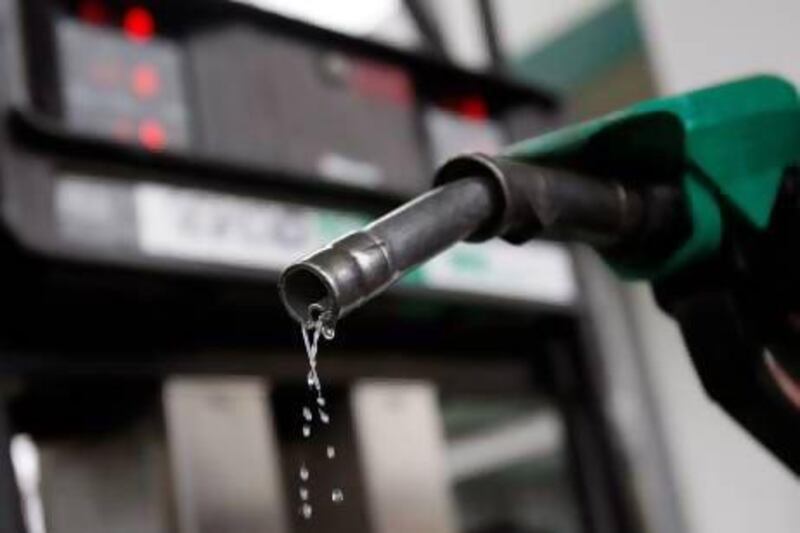It would seem a straightforward goal. The United States has a new, aggressive fuel consumption mandate; the Obama administration has issued regulations that force car manufacturers to more than double their average fleet economies to 54.5 miles per gallon (4.3L/100km) by 2025.
Unlike other similar attempts at draconian regulation, virtually all car companies are marching in step with the US government. Even those who disagree with the specifics of the new Corporate Average Fuel Economy (CAFE) standards realise that fuel consumption has become a front-burner issue for both consumers and activists.
However, it's not as straight forward as it sounds. For one thing, although the new rules claim all manner of benefits - consumers will supposedly save US$8,000 (Dh29,376) in fuel costs over the lifetime of their new vehicle, and will consume 2,000,000 fewer barrels of oil per day, etc - it's not exactly clear that 4.3L/100km actually means 4.3L/100km.
For instance, the CAFE ratings are far less stringent than those used by the more common Environmental Protection Agency rating displayed on a new car's widow sticker in the US. The Environment Protection Agency's (EPA) five-segment test is far stricter than the CAFE standard and, because of this more lax testing methodology, most analysts rate the 4.3L/100km CAFE figure as equivalent to a 5.9L/100km EPA rating.
Even that twist gets more complicated, since the CAFE 4.3L figure doesn't really represent 4.3L/100km, there being all manner of incentives for natural gas-propelled vehicles, plug-in hybrids and especially electric vehicles, as well as credits for incorporating technologies such as start/stop functions. Eliminate all the credits, say critics, and the CAFE standard looks more like 49.6mpg or 4.7L/100km. And that 4.7L figure actually corresponds to an EPA figure of approximately 6.53L/100km. Confused yet? Most are.
Nor will those supposedly credit-worthy vehicles have very much effect on overall fuel consumption. Electric vehicle sales, for instance, are tanking. Plug-in hybrids are doing little better and natural gas as a fuel for cars remains the purview of a few isolated fleet operators. Indeed, for the foreseeable future, most gains will be seen in traditional internal combustion engine-powered cars and conventional hybrids.
Unfortunately, even here, Americans are being misled as to how dramatically these new fuel economy standards may alter our vehicles. Any efficiency gains are likely to require dramatic sacrifices in the performance - as well as size and weight - of vehicles the typical North American drives. Indeed, all three aspects - performance, size and weight - will need to be reduced simultaneously; improving just one has surprisingly little effect on fuel economy.
Light weight alone, for instance, does not generate massive improvements in fuel economy. Despite losing an incredible 250 kilograms thanks to its revolutionary aluminium chassis (the first ever for a production SUV), the recently unveiled 2013 Range Rover boasts just a nine per cent increase in fuel economy. It sounds even less impressive when you measure actual consumption; after an engineering remake that just a few years ago would have been considered pioneering, the new Range Rover's overall fuel consumption has decreased from 16.8L/100km to a marginally better 15.68.
Making matters worse is that at least a part of those paltry gains has nothing to do with the weight loss, but the lower highway revs attributable to the Range Rover's new eight-speed automatic transmission. It's impossible to know the transmission's exact contribution (mainly because, in announcing the overall fuel economy improvements of their new vehicles, manufacturers hate crediting less marketable technologies such as multi-speed transmissions when they are trying to push upgrades such as turbocharged "Ecoboost" engines).
However, basic mathematics suggests that the increased number of gears is, by itself, good for about a six per cent boost in highway fuel economy. That leaves but a few points to be credited to its dramatic weight loss. Weight reduction will not, per se, result in huge fuel economy improvements, particularly on the highway.
Simply installing smaller engines in existing cars will not engender significant fuel efficiency gains, either. According to one Consumer Reports test, Ford's much-hyped substitution of a 3.5L, twin-turbocharged V6 for its traditionally V8 in its pickup resulted in absolutely no reduction in fuel consumption. Jaguar, meanwhile, has taken the measure to even greater lengths, introducing a 2.0L turbocharged four (the same as used in the Range Rover Evoque) in its full-sized XJ luxury saloon. Yet compared with the new 3.0L supercharged V6, the little four banger saves but 0.1L/100 km in fuel consumption (the 3.0 is rated at 9.4 L/100km while the 2.0 gets a 9.3 rating). Yes, in reducing performance from the 340 horsepower V6 to the 240hp four, one saves about three ounces of fuel for every 100 kilometres driven. No wonder Jaguar has declined to import the 2.0L XJ to North America (though the car is important in countries where taxation is based on engine size).
Even in real-world evaluation, the size of the engine is not as much of a factor as you might reasonably have presumed. Audi's A6, for example, is now available with the Volkswagen Group's ubiquitous 2.0L turbocharged four as an option to the long-running 3.0L supercharged V6. The good news is that the big Audi suffers very little from the downsizing of its engine, the turbocharged four cylinder doing a creditable job of motivating the big saloon. The bad news is that there's just not that much fuel economy advantage. In real-world testing at 120 kph, the 2.0T reduces highway consumption from the 3.0L's 7.6L/100km to 7.3 - about enough in 10,000km of highway cruising to save you enough for a nice bottle of aftershave. In the city, the improvement is slightly better, with the average dropping from 13.9L/100km to 12.9 - notable, but hardly planet-saving.
Why are the gains so paltry? One of the main reasons is that the most important fuel consumption criteria for highway fuel consumption is aerodynamics. At speed, how efficiently a car cuts through the air largely determines how much fuel it will consume. At a steady 100kph, weight is hardly a determining factor and, while engine efficiency is important, the largest gains are to be made with slippery shapes.
But, here too, there is more than meets the eye. Automakers have, for quite some time, misled the consuming public about the aerodynamics of their cars - not by outright lies, but rather the classic fib of omission. While often bragging about the slipperiness of their cars - usually denoted as a "coefficient of drag" - they have neglected to inform us that this is but one half of the equation determining how efficiently their car slices through the air.
The drag that air imposes on a moving car is actually a result of its drag coefficient multiplied by the size (actually the frontal area) of the car. That means that the size is as much a determinant of its highway fuel economy as its slippery roofline. Hence, a Toyota Yaris will always have less drag than a CLS63 no matter how aerodynamically Mercedes-Benz crafts its coupé-like exterior and why, beyond a certain point, reductions in engine size alone have little effect on highway fuel consumption.
On the other hand, weight is extremely important in the urban cycle. While accelerating from a stop, aerodynamic drag is hardly a factor. Instead, it is the act of acceleration (force equalling mass times acceleration, as Sir Isaac Newton first recognised) that is now the determining factor. It explains why a relatively heavy but sleek, saloon (such as that Audi A6 3.0T) I tested can eke out a creditable 7.6L/100km while cruising the highway at 120 kph, yet suck back a miserable 13.9L/100km while crawling around the city.
Nor are the much-touted hybrids likely to single-handedly save the day. For instance, the Ford C-Max Hybrid's fuel economy at a steady 120kph (7.5L/100 km), is little different from that of the much larger Audi A6 3.0T (7.6L/100km) mainly because a) at higher speeds the electric motor offers no fuel economy savings as the C-Max is being powered by the petrol engine alone, and b) though it is notably smaller, its frontal area is about the same as the larger, more powerful Audi, and so aerodynamic drag is similar. That it's powered by a smaller, naturally-aspirated four-cylinder engine boosted by an electric motor, while the A6 has a supercharged V6 matters hardly at all.
Even if you haven't followed all the physics, the fundamental message is that no simple, singular change will deliver dramatic improvements in fuel economy. To achieve the ambitious goals put forward by governments, cars will have to be dramatically smaller (for aerodynamic improvements on the motorway), lighter (for less load during city driving) and powered by significantly smaller engines. Two out of three won't do.
Indeed, if the US is serious about this, its national automotive fleet will have to more closely resemble the European fleet, where the average car is a compact-sized 2.0L hatchback. Quite how that will fit in with the USA's Super-Size Me culture, no one has yet explained.






